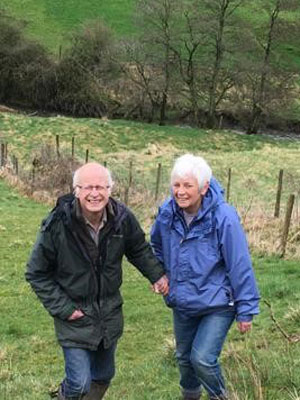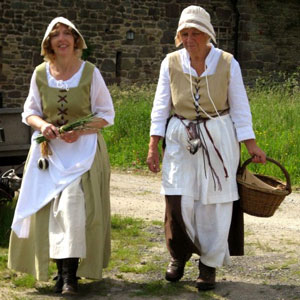#70People70Years - Elspeth & Paul Walker

Elspeth & Paul Walker - environmental educators
Elspeth and Paul Walker shared a dream about environmental education and sustainable living, they made it their life’s work. Under Whitle Farm, near Longnor, is the family hill farm of 50 acres where they put their ideas into practice.
Originally from Lancashire, Elspeth met Worcester-born Paul in the 1960s when they were training to be teachers at Matlock College. During their three years in Matlock, they got to know the Peak District through climbing, caving and walking clubs, as well as teaching practice placements in rural schools. They fell in love with each other and the place. They struggled to afford a house in the Peak District but managed to buy a ruin in Hollinsclough, which they restored. Paul was a teacher in Buxton, and later became headmaster at the rural primary school in Stoney Middleton.
In 1978, with the aim of owning a small holding and living off the land, the couple moved to Wales. Elspeth says: "We were part of a strong green movement, but we missed our family and friends and the Peak District, so, we looked to return and in 1982 we bought Under Whitle Farm – another derelict place - it was a bit of a theme for us! We lived in a caravan for a year with our three children – there was no mains water, no electricity and no an unmade track. We had beef cows and sheep, grew veg and kept hens." And Elspeth returned to teaching too. “We were both passionate about education and helping more young people to learn about the countryside, nature and farming. But we had no facilities for group visits. As time moved on, our old stone farm buildings became redundant for modern agricultural practices and we decided to do something different with them. We were able to get planning permission to convert the buildings to holiday accommodation and an education facility. We did as much as possible to be sustainable: using reclaimed materials, organic paint and employing local builders.

"In 2001, we established the Dove Valley Centre at Under Whitle, this gave us the space to run courses using professional artists and craftspeople from the local area – willow weaving, poetry writing, countryside skills courses and so on. Since then it has been enjoyed by many groups and families, many of whom we have got to know well."
In the early 2000s, they were working in partnership with Staffordshire Wildlife Trust and were part of the Vision 2020 project. This involved young people visiting them for environmental courses such as making bird boxes, planting hedges and more.
At this point, the old hay barn was undeveloped. Originally, their idea was to build a new eco building made from bales of straw - they tried unsuccessfully for four years to get planning permission. Instead, starting during the winter of 2008/9, they converted the hay barn to the Haybarn Studio.
Elspeth recalls: "It was so cold in the January that the JCB tracks froze to the ground and work was halted until it thawed." The work was completed by the summer. They had installed a ground source heat pump (which provides the hot water and heating for all the buildings), used lime hemp-crete insulation on the walls, and sheep wool as roof insulation, put in special window glazing that retained heat, used reclaimed timber and eco stains on the woodwork. "Turning the dream into reality was a real labour of love and hard work. We funded the work ourselves and with the help of a grant for redundant farm buildings. Our three grown up children were involved - Alex did the woodwork and made furniture, Steven did the excavating and ground work and Sarah and her husband Andy did the decorating and furnishings - it was a real family effort."
Typically wanting to share their experiences and what could be learnt from them, in addition to the building work, the Walkers jointly delivered the ‘Pilot Light Project’ which was about installing landscape appropriate technologies and sharing learning.
Working with the National Park Authority team, they joined the Countryside Stewardship scheme which supported hundreds of children to visit Under Whitle from local schools over a ten year period.
Elspeth and Paul were also part of the community which set up and supported the Rural Education and Arts Project REAP - which included recording oral histories, commissioning plays, and a revival of rural crafts.
And, they took part actively in the EU funded BESST project - Business and the Environment linked through Small Scale Tourism - which introduced an international perspective, and involved collaborating and sharing eco-friendly business ideas and experiences with others in rural Norway and Sweden.
Elspeth says: "From the start, when we first came to Under Whitle, we wanted to create many more diverse habitats, to increase biodiversity and protect and enhance the quality of the landscape and its historic environment and natural resources. And we wanted to share our ideas, understanding and the place with others."
Their approach tied in well with agri-environment schemes which supported their stewardship of the environment and countryside, and helped them create three new hay meadows and plant thousands of native hedgerow plants to restore hedges. Paul planted over 3,000 native trees to create a carbon storing woodland, including willow and hazel for coppicing. They created three ponds, enhanced the riverbank with planting, worked with the barn owl action group of the local wildlife trust. They also planted an orchard of traditional varieties of fruit trees, including the Beeley Pippin. The farmland is grazed by cattle and sheep, the wildflower meadows provide hay for during the winter, the woodlands provide fuel for the wood burners, and wetlands and ponds are ideal for wildlife and for people to explore.
Nesting birds include green and great-spotted woodpeckers, tawny owls and barn owls, as well as moorhens. Brown hares, badgers and foxes are regular visitors too. Over 120 species of flowers and grasses are found on the farm. Elspeth keeps a farm diary, noting in it the changing seasons, the comings and goings of wildlife – the return of the fieldfare, a heron standing in the pond, a kestrel overwintering in the barn owl box. And work continues to improve wildlife habitat. In 2021, with the South West Peak Landscape Partnership, two scrapes have been made to create shallow wetland habitat for curlew and snipe.
Elspeth acknowledges it can take a while to see results. "We keep working to increase the biodiversity of our hay meadows - but it takes time for some species to get established - it can take five years to see orchids after the seeds have been sown. But with the help of the South West Peak’s grasslands project, we have grown plug plants of different species, such as common knapweed, field scabious, sneezewort and autumn flowering hawkbit, and planted these out. You have to take the long-term view."
Tragically, Paul developed dementia and for the last two years of his life was unable to talk. He died in early 2021. Elspeth and the family continue to stay true to their environmental goals.
Elspeth says: "Losing Paul has been devastating, but we are determined to increase the biodiversity further here and restore more land for wildlife. This summer we planted wildflowers in the roadside verge. We are also developing a permitted access footpath between two existing paths so that people can walk through and enjoy the hay meadows. We will be installing an interpretation panel to explain to people what they can see - these fields are on the 1845 Tithe Map as hay meadows and they contain lynchets (strips of raised ground) from Medieval ploughing which shows part of the story and indicates how long this area has been farmed and supported livelihoods."
The farm is the site of an ancient settlement and has been in agricultural use since at least medieval times. Elspeth says: "As we walk across our fields we are constantly reminded of its history by the remnants of ridge and furrows left by ploughing with oxen. Ancient banks reveal old field boundaries and trackways. Flattened areas show where other farmhouses once stood – there is tangible evidence of one farmhouse as the vaulted cellar remains. Overlooking it all from across the river Dove are the remains of the Norman motte and bailey castle of Pilsbury built by William de Ferrers around 1080."
Talking to Elspeth, it is soon apparent that she and Paul have repeated a pattern throughout their lives and interests - seeing opportunities, rolling up their sleeves and making things happen. Raising awareness of the importance of Pilsbury Castle is one example. Elspeth had observed that although the site was a scheduled ancient monument, its remote rural location meant that the site was under-appreciated. Enlisting the support of National Park rangers, a group set up a project to raise awareness - led to the development of guided walks for local school children with characters in costume, a public open day at Pilsbury Castle that included a Norman re-enactment group as well as walking leaflets explaining its history.
Following this, a growing band of like-minded friends including National Park rangers with a shared interest in local history, formed the Tudor Farming Interpretation Group TFIG. Focussing on the history of Under Whitle they organised free costumed events for schoolchildren based on the farm with hands-on activities including weaving, spinning, cooking over an open fire, writing their wills with a quill and experiencing what it was like to live here in Tudor times.

In 2013, they won a national Bayer Cropscience/FACE (Farming and Countryside Education) Innovative Learning Award for developing and implementing new learning experiences that have inspired and encouraged young people. Receiving the award at a ceremony in London's Chancery Court, Elspeth explained there was extra significance as she had studied historical records that revealed five hundred years earlier William Horobin, of Under Whitle, had stood in the same building to state his case for ownership of the farm in a dispute over the land. "It was extraordinary to be in this medieval hall reading the menu, knowing that William had been here before us, fighting to keep his home."
One project led to another, and the TFIG extended its interest from history to archaeology and were awarded a Heritage Lottery grant for the Peeling Back the Layers community archaeological project. Schoolchildren, young archaeologists, local history enthusiasts and mental health groups came to explore Whitle's history and archaeology. The legacy from this project included public events, talks, a book, information panels on site and a self-guided heritage trail with permitted access.
Elspeth and Paul were excited to find out details of families who had lived at Under Whitle - the Harrisons from the 16th to 19th centuries, the Horobins from the 15th to the 19th century. Charcoal from the site was radio carbon dated to around 1350 so we know that people were living here even earlier than these families.
Further funding was gained from the National Lottery Heritage Fund and the Peak District National Park Authority’s Community Small Grant Scheme for the Digging Deeper project which, following delays due to the Covid-19 pandemic, enabled work to continue at the site in August and September 2021, and involve more people in exploring the past in the present landscape. "We were able to extend a welcome to the Asha group from Stoke and the Mosaic group from Sheffield as well as more young people and volunteers.
"We still haven't found the site of the Medieval house but we did find late Medieval pottery. Soil core samples were taken by archaeo-botanists and we are looking forward to hearing the results of these in 2022 – these will show what seeds are present in the soil so that we know what plants have been grown here, which will help us understand about past farming practices." Further history research will help us understand more of the origins of Whitle and its people.
Putting the environment front and centre has been at the heart of everything the Walkers have achieved. In the early 2000s, when the National Park Authority was creating the Peak District Environmental Quality Mark, Elspeth and Paul were among the first businesses approached to participate in the scheme and were awarded the EQM in 2003. The Dove Valley Centre still holds the EQM.
“It was great to have formal recognition that we were trying to provide an environmentally friendly business. We were given guidance in recording what we were doing and being part of a group of people with common aspirations, which was important – you can often feel isolated running a rural business. We were able to share our experiences and learn from others, which helped us think things through for our own business.”
They have continued to support the EQM but as Elspeth says: "Ultimately, the hope is that one day it won’t be needed as everyone will be running their businesses in environmentally friendly, sustainable ways. We are in the middle of a major crisis of habitat loss and climate change of shocking proportions. From studying our own local history, people have come through the Black Death, bubonic plague, and climate challenges - they have been stoical, adaptable and we have got to continue to be resilient and try to ameliorate what’s happening with determination. Working together to retrieve the situation is essential for our future. We know from our own partnerships with the Wildlife Trust and the National Park rangers that we can find ways to achieve things. We all have to work together."
Back to 70 People 70 Years.

